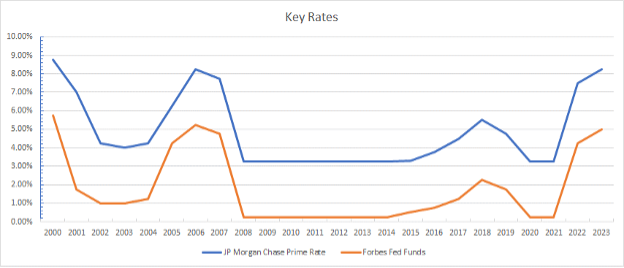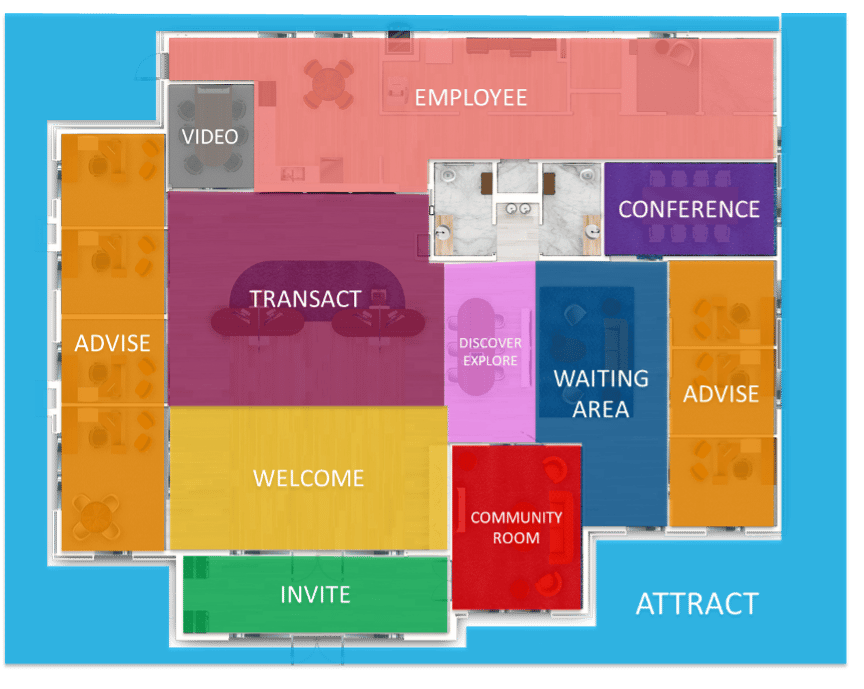Core Deposit Growth Strategy: Part 1
- Consulting
- Credit Union
- Retail
Categories:
Understanding Historic Trends is Critical for developing & executing strategy for core deposits growth

This is part 1 of a 3-part series to help credit unions develop effective, long-term strategies to grow core deposits.
What Was the Financial Industry seeing in historic trends for core deposits in January 2000 and How Has it Affected Today?
Let’s set the stage by thinking back to January 1, 2000. We all awoke with a wary eye. Had our efforts to ensure all our electronics were Y2K compliant succeeded? Or had civilization imploded at the stroke of midnight due to a glitch that the earliest programmers never envisioned? The glow from our bedside alarm clocks gave us a glimmer of hope. When our trusty coffee makers bubbled to life, we began to rest assured that life would go on indeed.
When we were in our “just glad to be alive” moment, we couldn’t imagine the changes that the next twenty-plus years held for our economy and the financial services industry.
Strategies for the Future of Financial Services Should be Informed by the Past
Although the economic shifts in the last 2-3 years have appropriately created a growing level of concern for credit unions, additionally considering the past two decades puts today’s financial landscape in clearer perspective.
A review of the prime and Fed Funds rates will give us insight into the challenges we’re facing today.
Following the dotcom boom and Y2K was the dotcom bust. Then the horror of 9/11 weighed in and rates headed for the cellar.
The economy regained its strength, largely led by a housing boom, and rates went up.

Then, like a lightning strike, the housing bubble burst, and we found ourselves in the “Great Recession.”
This resulted in a protracted period of unbelievably low rates. Again (and predictably) home prices started to rise, and rates were adjusted upward. Then came COVID, and the rates were pushed back down to their historic lows.
Eventually and thankfully, the pandemic subsided, but we were faced with “new normal” conditions—just to name a few examples, remote work became more of the norm, retirement/resignations spiked, and a blistering housing market ensued. In response to this “new normal” the Federal Reserve instituted fast-paced, significant rate hikes to the point that nothing about our economy seems certain.
How Did We Get Here?
It’s clear that the season of very low rates resulted in a readjustment in personal and corporate budgets. Low rates made everything more affordable and we adjusted our sails to take advantage of the favorable breeze.
For the financial services industry, there is a renewed focus on core deposits. Why? The low-interest rate days are gone and unlikely to return. Borrowing to fund lending is significantly more expensive.
Further, borrowing of any sort is more expensive, which threatens loan demand. Highly-driven lending teams are constrained by the institution’s ability to fund loans and maintain adequate spreads.
This is all brought up to make this point…There are banking professionals in the industry who have 15 years of experience on their resumes but have never experienced a “normal” rate environment. It’s not their fault—they couldn’t choose the year they were born!

BUILD WITH CONFIDENCE
Put LEVEL5’s proven expertise to work for you. De-risk your future growth with the strategy, technology, site selection, design, and build services you need to launch the next phase of your credit union’s branch network.
Our Team Helps You with Core Deposit Growth Strategy in Today’s Market
Given the current economic landscape, now is certainly the time to reexamine your credit union’s strategic planning for the long-term. In many ways, the conditions that threaten the industry are more of a “return to normal” adjustment than a doomsday scenario.
To find solutions to guide us into the future, we need to understand more of the industry’s historic response to similar conditions and return to some tried-and-true long-term strategies for sustainable growth.
What are those strategies? That’s what we’ve covered in the next parts of this series.
Growing Core Deposits Blog Series Part 2 ➝
Growing Core Deposits Blog Series Part 3 ➝
Have questions today? Please contact us! For over 2 decades, LEVEL5 has developed winning credit union growth strategies through every ebb and flow of the economic landscape, so you can certainly say we know a thing or two about charting a course for a healthy future.
A Modern Playbook: Leveraging Big Data for Decision Making in Financial Institution Growth and Branch Design and Construction
- Banks
- Consulting
- Credit Union
- Data
- Services
Categories:

With LEVEL5’s 20 years of experience, we have developed a modern growth playbook that relies on big data rather than old-school intuition, providing quantifiable insights that have consistently achieved business success.
In this article, we will explore the significance of data in expanding financial institutions long-term, the limitations of intuition, and how LEVEL5’s data-driven approach can help your institution make strategic decisions with unparalleled precision.
The Power of Data
Data vs. Information
Data is the foundation, but it is the interpretation of that data that turns it into actionable information. Think of an alarm clock displaying the time—it’s data. The actionable information is that it’s time to wake up. Similarly, financial institutions need actionable information—what to do and when to do it—derived from data in order to make informed decisions.
Using Data for Strategic Branch Network Decisions
LEVEL5’s Strategic Consulting Group has a finely honed analytical process, utilizing both private and public data points. We have developed custom algorithms that provide fool-proof, data-driven facts to guide strategic decision-making. This approach ensures that expansion market decisions are not based solely on intuition, but rooted in concrete data.
Market Analysis for Credit Union & Bank Growth
When assessing new expansion markets, relying on intuition is no longer sufficient.
For example, when considering a new branch location, perhaps a specific idyllic area in the community first comes to your mind.
You might “feel” this is a prime spot for growth, but how far does this “feeling” really get you?
Sure, it may be a well-trafficked area, perhaps near a hub of retailers, but what if there are even more optimal locations in your town unbeknownst to you, spaces with even more traffic, even more of your member demographics, and with even more potential for future growth?
It pays to know!
That’s why each market decision must be backed up with careful, in-depth analysis that helps you minimize unknowns and maximize potential.
LEVEL5 has been assisting clients with market analysis for two decades. Our comprehensive approach examines state, county, metro, and trade areas to determine growth trajectories that make sense both in the present and for the next 5-10 years. The resulting reports provide clients with a 10-year branch pro forma, offering accurate visibility into how a branch will perform on a specific street corner.
By analyzing data at various levels, including state, county, metro, and trade areas, we provide actionable insights that enable informed decision-making.
De-risking Growth Decisions with Unbiased Data
The Role of Data in De-risking Decisions
Data provides clarity and reduces uncertainty when making growth decisions. It allows financial institutions to understand their “elbow room” in a given market and forecast performance accurately.
By running multiple pro formas that consider branch types, personnel, and technology fit, LEVEL5 ensures decisions are based on reliable data rather than subjective intuition.
Data Points the Way
The Power of Data-Driven Decision Making: Insight Beats Intuition
Data-driven decision making is not new. Industries such as e-commerce and sports have long embraced the power of data to enhance their strategies. Financial institutions can also harness this power to inform their branch playbook and make well-informed decisions.
By basing your decision-making on quantifiable insights rather than intuition, you set your financial institution—whether a community-owned bank or credit union—on a path toward sustainable, long-term growth.
LEVEL5’s Holistic Approach
LEVEL5’s approach to strategy and market analysis goes beyond traditional consulting engagements. We combine market analysis with site selection, ensuring that the quantifiable insights provided are actionable. Our comprehensive process involves two main components: critical inputs and outputs.
Critical Inputs:
The critical inputs for LEVEL5’s market analysis are derived from a range of data sources. These include proprietary data points exclusive to LEVEL5, as well as data points specific to the financial institution itself.
Staffing interviews provide qualitative and quantitative insights, while market segmentation analysis and trade area analysis contribute to a comprehensive understanding of the market.
Outputs:
The outputs of LEVEL5’s market analysis process provide clients with actionable information.
A 10-year pro forma offers visibility into a branch’s performance, including key factors such as loans, deposits, and return on investment.
Branch type models allow for flexibility in considering different branch types, while the staffing model helps evaluate the impact of personnel on performance.
Additionally, technology-needs assessment ensures that capital costs related to technology are considered in growth decisions.
Grow Your Financial Institution with Confidence Through a Data-Driven Strategy
In the dynamic world of financial institutions, and especially in a tough business environment like the one we’re facing today, relying solely on old-school intuition is no longer enough to stay competitive. By embracing big data and adopting a data-driven approach, financial institutions can make informed decisions and build with confidence.
LEVEL5’s expertise in utilizing data and providing actionable insights has made us a trusted partner for financial institutions looking to design and build successful branches.
By leveraging the power of data, LEVEL5 helps financial institutions navigate the evolving landscape with assurance, backed by accurate insights and strategic decision-making.
Contact LEVEL5 today to learn more about our proprietary data-driven approach and unlock the growth potential of your financial institution.
3 Reasons to LAUNCH: Alignment
- Announcements
- Banks
- Branch Transformation
- Credit Union
- Leadership
- Retail
Categories:
We Have Liftoff
LEVEL5 has officially launched our LAUNCH Program.
This program has been specifically designed for the Credit Union and Bank executive who has a clear vision for the next 3-5 years, but is struggling to execute to these goals.
In this article, we discuss the second phase of our LAUNCH Program.
Phase II: Alignment

Phase I was the Discover phase, where we got to know each other, but most importantly, discussed current and future states, with goals and objectives laid out, but also discussing what’s been getting in the way of successfully executing to these goals.
In Phase II, we discuss the Alignment of your goals to our services. You did most of the talking in Phase I, now it’s our turn.
We will take the information we discussed, and add insights. We’ll present initial data to add value to our conversations, while also laying down a firm roadmap on how to break through the roadblocks and initiate plans to help you achieve your goals.
Based on relevancy of the need, we’ll recommend paths forward relating to Market Analysis as part of our Strategy service, as well as Site Selection to ensure geographic analysis aligns with available land and buildings in your desired Trade Areas.
Technology is a key strategic component in the branch. We’ll discuss options relating to the right “Tech Fit” across your current and/or future locations.
And finally, we’ll walk you through the Design and Build phases, speaking to budgets and timelines.
When relevant, we’ll also discuss previous efforts in the form of Case Studies, or share insights into current jobs that have relevance to your scenario.
Why LAUNCH At All?
The LEVEL5 LAUNCH Program follows a methodical, yet casual approach to uncovering the critical needs of your Financial Institution. Through a series of easy discussions, our team will be able to capture your goals, but also understand what is getting in the way of you achieving them.
From there, we’ll be able to make actionable recommendations on how to execute to these goals.
To learn more about our LAUNCH Program, and to schedule your first Discover call, Contact Us today to get going.
3 Reasons to LAUNCH: Discover
- Announcements
- Banks
- Branch Transformation
- Consulting
- Credit Union
- Leadership
- Retail
- Services
Categories:
We Have Liftoff
LEVEL5 is excited to help your FI with your growth initiatives in 2023 and beyond with our LAUNCH Program.
We’ve built this phased approach to assessing and launching your growth strategy around the methodical steps aimed at uncovering the challenges getting in the way of your Credit Union or Bank achieving its objectives and goals.
Phase I: Discover

The first phase in. our LAUNCH Program is called “Discover” – when our relationship will begin with a casual conversation, no more than 30-minutes, where we simply have a chat.
In this discussion, we’ll go over our services and background – but this phase is frankly about you. We’ll want to know about your FI’s history, your place and positioning in the communities you serve, and most importantly, current state versus desired state.
Your “Current State” is where you are today – number of branches, trade areas, assets, branch type mix, and of course, your member/customer base.
Your “Desired State” is where you want to be – expansion plans, asset goals over the next 3-5 years, thoughts on branch types, hub & spoke models, as well as any M&A’s that may be in play.
From here we’ll start to discuss next steps. Most importantly, we’ll need to uncover what is getting in the way of you executing and achieving your goals. That bridge from here to there is typically full of roadblocks, but that’s where LEVEL5 comes in.
Why LAUNCH At All?
The LEVEL5 LAUNCH Program follows a methodical, yet casual approach to uncovering the critical needs of your Financial Institution. Through a series of easy discussions, our team will be able to capture your goals, but also understand what is getting in the way of you achieving them.
From there, we’ll be able to move into the other phases of the LAUNCH Program and make actionable recommendations on how to execute to these goals.
To learn more about our LAUNCH Program, and to schedule your first “Discover” call, contact us today to get going.
The Branch and Its Zones
- Banks
- Branch Transformation
- Brand Deployment
- Credit Union
Categories:
In order to ensure that your branch runs as efficiently and effectively as possible while also meeting your members’ expectations, you must consider the Branch Zones and how your floorplan is built strategically to support those zones.
This will make or break the Member Experience in your branch.
The branch zones determine the function of each section of the branch, beginning from a warm entrance, to advising, transacting, and even providing places to rest and reenergize. Every single part of the branch should be built purposefully with strategy behind the design and elements in each area. Not only that, but they should also be built to optimize member and employee directional flow according to their placement next to each other.
A correctly-zoned credit union or bank branch prototype design is vital for a positive overall Member Journey as it fosters seamless and logical progression from one space to the next.
This strategy provides your members with a nearly effortless and intuitive visit into and throughout your branch, making it easier for them to achieve their financial purposes and goals with your team and more enjoyable for them to return again and again!

Use the graphic above to reference as you read more about each zone and its purpose.
ATTRACT ZONE
This first zone is the exterior of your branch. It not only includes the building façade, but the entire property as well, which will likely include road signage, drive-thru, directional signage, and landscaping. This zone should work for you 24/7, day and night.
Key Elements:
- Road Signage
- Building Signage
- Nighttime Illumination
- Iconic Design Elements
- Entry/Exit Points
- Directional Signage
- Drive-Thru
INVITE ZONE
This zone is the first entry point of the branch, also referred to as the vestibule. This zone may include double entry doors, 24-hour ATM/ITM’s and be well-lighted for nighttime use.
Key Elements:
- Card Entry
- Lighting
- 24-hour ATM/ITM
- Branding
- Marketing Signage
- Branch Hours
- Music
WELCOME ZONE
The Welcome Zone is the first zone of the main branch. It should have key lines of site to employees and other, easily accessible zone through the branch. This is also a key point for visitors to be welcomed and directed to their needs.
Key Elements:
- Well-lighted
- Cleanliness
- Visibility/Good Lines of Sight
- Digital Signage
- Branded graphics
- Iconic feature
- Universal Banker/Greeter/Concierge
TRANSACT ZONE
Likely the anchor point of your branch, if not the traditional purpose of a customer or member’s visit. Can be the central design element, or off-set based on strategic intent.
Key Elements:
- Teller Pods
- Traditional Teller Lines
- Drive-Through Screens/Tubes
- Cash Recyclers
- ATMs
- ITMs
- Assisted Self Service
DISCOVER/EXPLORE ZONE
This is a multi-purpose zone meant for self-discovery of products and services, while also acting as an informal location for onboarding and semi-private advisory sessions.
Key Elements:
- Touchscreens (Large Format and/or Tablets)
- Digital Signage
- Tech Bar
- Consulting/Engagement Fixtures
- Marketing Collateral (Traditional or Digital)
ADVISE ZONE
A critical branch differentiator when compared to digital channels, the Advise Zone affords opportunity for in-person dialogue, counseling and advice and acts as an important component in account openings, cross-selling and thus share of wallet.
Key Elements:
- Consulting/Engagement Fixtures
- Offices
- Computers/Touchscreens
- Digital Signage
- Traditional Signage
COMMUNITY/CONFERENCE ZONE
Whether combined for smaller footprint branches, or as separate zones/rooms for larger square-foot branches, this zone acts as an opportunity for employees to huddle and meet, whether they be branch staff, or those from corporate using the rooms for miscellaneous meetings. Additionally, the room can be offered to the community as a gathering place, which can be booked independently, with it also having an “off hours” entry point for non-employees.
Key Elements:
- Digital Signage
- Two-Way Video
- Table and Chairs
- Community/Branded Wall
VIDEO ZONE
A smaller room suited for a customer or member to communicate with a “remote expert” via 2-way video.
Key Elements:
- 2-way video (camera & screen)
- Remote Expert at secondary location
- Room for several customers & Employee
- Can act as secondary office
EMPLOYEE ZONE
Also considered “back of the house” for employees, this zone will likely the critical elements for an employee’s need before and after work, as well as during lunch breaks.
Key Elements:
- Tables
- Lockers
- Quiet Room
- Refrigerator
- Kitchenette
- Tablets/Computers (personal use)
Contact LEVEL5 to enhance your Credit Union or banking member experience!
A seamless, interactive journey throughout the branch is imperative to take care of your members’ needs. They want to be comfortable with their financial institution, knowing that they can trust that their finances are in good hands, and the first step to building trust is creating a high quality, unparalleled in-person branch user experience.
Here at LEVEL5, we understand the importance of the Member Journey. It is an undeniably important concept to consider when we design and build credit union and bank branches for our clients. We have the years of experience needed to execute this strategy, enhancing your branch in your network with a modern, effective floorplan zone that speaks to your members’ needs.
Contact us today and find out how we can help you!
The LEVEL5 Construction Warranty Process Explained
- Banks
- Branch Transformation
- Brand Deployment
- Consulting
- Credit Union
Categories:
When you embark on your next credit union or bank branch construction project, you’re making an investment in your growth for years to come. That’s why you want to know that all aspects are completed correctly during the build process, so your facilities will work properly to meet your goals.
Here, we want to break down our One Year Warranty process that’s offered on new branch Design-Build projects so you can better understand how your investment receives an extra layer of protection. Remember, each individual contract is different, but here we provide a general overview.
Let’s jump in.
When Does The Warranty Begin?
Warranty start date can be determined by one or a combination of the following scenarios:
A. When the building is occupied and used by the Owner for its intended purpose. Sometimes, owners move in before the final punch list is completed, but when this occurs, the owner gets Beneficial Occupancy and is utilizing the building systems.
And/Or
B. When the final punch list is generated and then subsequently addressed and completed by the General Contractor and then when the Architect Officially Issues the Certificate of Substantial Completion (this is contingent upon the punch list being completed satisfactorily.)
If you’re unaware of what a punch list is, it’s a document created towards the completion of a project, which identifies work that has not met specifications of the contract. It is generated by a site walk-through with the LEVEL5 Superintendent, Project Manager, the Owner (You), and the Architect.
Before a final payment is issued, the General Contractor must successfully resolve all outlined tasks.
The key to warranty is when the project is substantially complete and contracts vary as to the definition of Substantial Completion. Every contract can be different. From our perspective, the key is the definition of Substantial Completion.
What Does The Warranty Cover
Speaking in the turnkey context, a warranty will essentially cover all aspects of the building’s structural quality, appearance, and function including, but not limited to:
- Design flaws by the Architect
- Mistakes made by any Contractors
- Damage to items or spaces
- Incorrect installation of equipment/malfunctioning equipment
- Promised elements that were not delivered
When orchestrating a project, we create subcontracts with Subcontractors.
Subcontractors are often referred to as Trades and are managed and directed by a General Contractor to complete specific aspects of your project. Some examples of common Subcontractors include the Electrician, Roofer, Landscaper, Window Installer, Brick Mason, etc… These subcontracts have a One Year Warranty, which runs concurrently with LEVEL5‘s overarching general contract.
The General Contractor will typically dictate to Subcontractors when their One Year Warranty on work begins. Our contracts with them allow us to require that they solve any issues resulting from their work on the project.
In addition to the One Year Warranty period, there are multiple separate Manufacturers’ Warranties running congruently from your project.
For example, the manufacturer of the roofing products, flooring materials, plumbing fixtures, HVAC systems, etc., usually provides a warranty on those materials. The warranty timeframe varies depending on the product, but works to cover factory defects if they occur.
It’s crucial to note that warranties normally don’t cover problems that are a result of neglecting prescribed maintenance. Maintenance requirements are usually specified in close– out documents at the end of a project.
The Final Step of The One Year Warranty
The final step is to ensure all final warranty items are accounted for and solved for by the 12-month mark.
This final walk-through is made 30 days before the One Year period ends and is typically attended by the Owner and our Project Manager.
If there are outstanding warranty items requiring a solution, our team quickly takes action to ensure that the proper party responsible resolves the issues as soon as possible.
Contact us to learn more details on our extensive warranty. We work meticulously so that your final building is up to world-class standards, ready to meet the needs of your institution.
national vs local general contractors
- Banks
- Branch Transformation
- Credit Union
- Retail
- Services
Categories:

When you’re a community based credit union or bank, and you’re looking ahead to your next branch construction project, the question of whether to hire a national or local general contractor is a worthwhile topic.
In one regard, you want to keep dollars local – after all, you pride yourself on being a “local” financial institution.
On the other hand, you want to keep costs down, and want a GC who can save you money, while also managing budgets and schedules.
Can you have it both ways?
In short – yes.
In this article, we’ll take a full look into the advantages of partnering with an experienced national Design-Build firm while also utilizing expert local Subcontractor talent within your institution’s local markets.
A National Design-Build Contractor Brings National strength and scale
More Experience
A national General Contractor has most likely completed a higher volume of projects, on a larger scale, compared to a local General Contractor. This means a national General Contractor has seen more and done more overall, bringing a broader range of expertise and can offer inputs from a larger team to advise on your success.
But just because a national GC may have their HQ in a different state, doesn’t mean there is not local representation. LEVEL5 always places a full-time, seasoned superintendent on each project, dedicated to working with Subcontractors and seeing it through to completion.
More Buying Power & STRONGER Relationships
A local General Contractor certainly won’t have the national buying power and broader relationships that allow a national General Contractor to pass on substantial cost savings to their client.
Because LEVEL5 has multiple projects at one time across the nation, we are able to consolidate purchases for materials, whether it be lumber, steel, even furniture.
And to be clear, LEVEL5 always works with as many local Subcontractors as possible. We have a robust national database of contractors across all trades in nearly every market. We’re also glad to work with your preferred local Subcontractors.
Due to our licensing and work history in all 48 contiguous states, we’re able to pull from a preferred list of competitive and trustworthy local Subcontractors within your area.
However, when there’s an opportunity to benefit our client with more savings and optimized delivery, our national frame allows us to tap into partners from other parts of the country accordingly.
For example, we always ensure that Subcontractors will actually have the availability to work on your project.
Sometimes the provider right in your own city may not have capacity and are unable to allocate resources a few miles down the road. With our network, we can resolve this issue ahead of time, sometimes securing an available sub who may not be local, but who is definitely experienced and available.
This sometimes translates into cost savings for you, too! In some cases, we may know a sub elsewhere who can work on your project for a substantially lower price than similar local Subcontractors are offering.
Specialized In Your Vertical
Many local General Contractors serve a wide array of industries…this isn’t inherently bad, but pertinent to note that they likely don’t have a comprehensive understanding of success for your particular vertical’s needs. They may be good at construction, but they are not EXPERTS in building a branch.
In LEVEL5‘s case, we have specifically provided our services to financial institutions nationwide for nearly 20 years.
With a committed team who has managed over $1 Billion in successful construction of branches, operations centers, and call centers, holistic, practical know-how in building for credit unions and community banks comes with the territory.
Keeping Your Subcontractor Dollars Local Has Huge Benefits
Reduce Your Costs
First off, you’re likely going to keep your costs lower by utilizing local Subcontractors.
Subcontractors near your construction site area are closer to the end of the supply chain for needed materials, equipment, and parts.
That generally means (but not always) lower prices for sourcing to your project if you were to compare against sourcing from Subcontractors who are further away from you.
Think of the costs needed for mobilizing a large backhoe, it’s going to be far cheaper moving it 10 miles down the road when compared to moving it from Florida to Texas.
LEVEL5 realizes this cost value that local Subcontractors bring, which is why as mentioned earlier, we try to hire them locally as much as possible, unless we see an opportunity where a non-local Subcontractor can benefit you more!
Be a True, Known Community Player
Beyond reducing your spending, keeping a majority of labor dollars local is a great Public Relations spotlight. You’re investing right back into your community, with the same folks who may even me your clientele.
Local workers on the job will spread the news of your soon-to-be branch. Families, friends, neighbors, word travels fast and when the general community realizes you’re hiring local Subcontractor businesses, it will only help solidify your standing as an organization truly dedicated to its people. Community members will take this to heart and it may even push them to consider opening an account with you.
Closer By, Quicker Response
If needed, local subcontractors can return quickly to your project site to resolve any issues or to coordinate and communicate with other Subcontractors since they’re right in the area nearby.
This would present obvious logistical problems if you were working with a sub from out of state or across the country.
For all our projects, we utilize only local Electrical, HVAC, and Plumbing Subcontractors specifically for this reason.
Imagine your branch’s heating system failing during mid-winter in Wisconsin…you’re going to want the familiar team within arm’s reach so that repairs can be made ASAP and operations can return to normal.
National + Local = A Win For Your Project
With the expansive reach, experience, and oversight delivered by a national General Contractor working in tandem with the local network of skilled, responsive Subcontractors, your project is set up to be completed with total success.
Contact us for your next project and get the best of both worlds.
5 Key Elements to Consider For Your Prototype
- Banks
- Branch Transformation
- Credit Union
- Retail
Categories:
Any branch project should always start with, if not be greatly informed by, a solid strategy.
As you begin the efforts of considering and planning a new prototype branch (whether it be with LEVEL5 or you go it alone), we present to you 5 key elements for you to consider as you form a final strategy.
1. Prioritize Customer Experience
Customer experience in the branch is paramount. That’s why so many branches are moving past the traditional, stuffy teller line-oriented layouts and replacing them with a more open floor concept design. These designs are considered commonplace by now and foster open communication.
Technology like Assisted Self-Service machines give your clientele the power to make transactions themselves and helps them avoid standing in frustrating lines.
But don’t forget the small things! Comfortable seating in a waiting area with coffee at the ready is still a great way to deliver on the customer experience.
2. Design For Your Brand
Your brand helps you relate to your members, so tailor the design to appeal to the right demographics and to properly portray your organization’s values.
The branch and its design are the physical manifestations of your brand. It should portray your mission and values, while also reflecting your overall member/customer base, even at the trade area level.
LEVEL5 has worked with many FI’s who operate both in a rural and urban settings. While there is an overall branch prototype, the design is specific to the neighborhood – and its clientele.
3. Integrate Technology According To Your Needs
Studies illustrate that the majority of consumers enjoy using touch-screen interfaces and automated tellers while at their branch. These technologies reduce wait times and free up your employees so they can assist others or accomplish other tasks.
But the latest and greatest may not always fit your brand, per se.
Again, decisions should be based on your members’ unique needs, so always consider that beforehand.
For example, many of your clientele may be senior citizens who would prefer a more personal approach. If that’s the case, a blend of the old and new may be worthwhile.
4. Use Natural Elements
The days of the deep, dark wooden panels are gone.
Branch designs have moved to using more natural elements. Not only is this design aesthetic more common, it is also more pleasing to the visitor.
It reflects your brand better, and provides a better branch experience.
5. Make Your Exterior Shine
There are 2 major elements when considering your exterior:
- Brand – Does the exterior design reflect your brand well
- Billboard – Your branch is an advertisement. Make it work for you 24/7
Your branch is your member’s “banking home” so have the overall design reflect that mentality.
You know your members best so how can the branch reflect them?
A modern branch can have large windows, metal siding and technology.
A traditional branch has deep woods, brick and maybe even columns.
There is not necessarily a right or wrong approach, but rather the branch, and the strategy to designing the prototype needs to reflect your brand and your clientele.
Contact our team now to discuss your new branch prototype. For nearly 20 years we’ve utilized best design build practices to help a multitude of clients create and implement effective, beautiful branch templates.
Designing Your Branch Prototype
- Banks
- Branch Transformation
- Credit Union
- Retail
Categories:
Your branch is the physical manifestation of your institution, oftentimes a critical beacon for attracting new members in the market and in growing the client relationships you already have. That’s why it’s so important to make sure you get branching right.
With your branch space, you’re providing a place where people can interact with an actual person to provide solutions. It’s the arena for primarily opening accounts, having questions answered or taking care of larger or more complex transactions. Digital channels simply cannot provide the desired human element, or solve the complex issues your clients face every day.
When looking to reinvent your brand, sometimes the branch, and a new prototype at that, is what is needed to begin anew.
Why? Because a new prototype branch universally establishes and dictates your brand and culture. It should provide the functionality and services needed to fit the changing requirements of your modern clientele.
In fact, almost all of LEVEL5‘s projects involve a new branch prototype. Wise financial institution leaders truly see the value of it.
In this article, we’ll cover the purpose and successful implementation of a prototype and what it means for you in 2022 and beyond.
When Do You Need A Branch Prototype? How Is It Developed?
You need a branch prototype when you want an effective, uniformed, comprehensive way to optimize your entire branch network. Notice we said your entire branch network, not just the future locations that are built to turn heads in newer markets.
Once your critical branch elements have been identified and put into the design, they can be translated into all of your existing branch spaces too.
This is monumentally important to point out since many credit union and community banks often look up one day and find themselves with multiple locations having a stale, unengaging ambience to them. A prototype helps with needed rejuvenation as well as future builds.
So how is it developed?
While putting your prototype together, we work closely with you and key stakeholders through an in-depth Programming and Visioning phase to identify and deeply understand your:
- Needs
- Goals
- Retail Strategies
- Influences
- Brand Elements
We then synthesize all of this into a design with our experienced Design team.
Once finished, your prototype branch will include the basic structural outlines, preferred technology, design choices, banking equipment, brand deployments and iconic elements, narrowing down to aspects like your furniture style, tile selections, and carpet color.
Tweak Your PROTOTYPE to Fit Varying Needs
Having an excellent branch template makes it more convenient to proliferate uniformed locations in a myriad ways, allowing you to minimize time and cost spent re-designing as the prototype can simply be adjusted to fit.
Your standard-sized floorplan can be seamlessly translated into micro branches, stand-alone kiosks in smaller towns or even for your regional offices or Ops Center, keeping your design components and member experiences in lock-step with your strategy.
Contact our team now to discuss your new branch prototype. For nearly 20 years, we’ve utilized best design build practices to help a multitude of clients create and implement effective, beautiful branch templates.
3 Reasons to LAUNCH: PROPOSAL
- Announcements
- Banks
- Branch Transformation
- Credit Union
- Leadership
- Retail
Categories:
We Have Liftoff
LEVEL5 has officially launched our LAUNCH Program.
This program is perfect for the Credit Union and Bank executive struggling to execute their strategic goals.
Phase I was the Discover phase, Phase II was Alignment. In Phase III, we’ll discuss the delivery of the Proposal and what that means to getting you that much closer to Liftoff.
Phase III: Proposal

By Phase III, if we’ve done our job, we’ve listened intently, captured all of your thoughts and concerned, and have now translated them into a Proposal for your review.
In this proposal, we’ll outline the overall scope of services, whether they be singular, or reflect an integrated deal, where all of our services are reflected, to present budget considerations and proposed schedules.
In this Phase, we’ll look to set up one final call, where we’ll be able to review the proposal, but most importantly, allow you the opportunity to ask any final clarification questions because from here, this proposal is either signed, or goes to the Board for final approval and signature.
Once the proposal is signed, we are officially at LIFTOFF.
While your project has been accounted for up to this point, the execution of the Proposal allows for your project to officially be assigned. Depending on scope of services, you will be introduced to your project lead and the project will commence in earnest.
Why LAUNCH At All?
The LEVEL5 LAUNCH Program follows a methodical, yet casual approach to uncovering the critical needs of your Financial Institution. Through a series of casual conversations, our team will be able to capture your goals, but also understand what is getting in the way of you achieving them.
From there, we’ll be able to make actionable recommendations on how to execute to these goals.
To learn more about our LAUNCH Program, and to schedule your first Discover call, Contact Us today to get going.